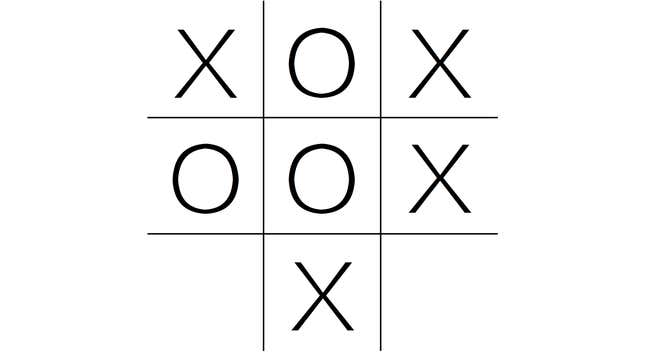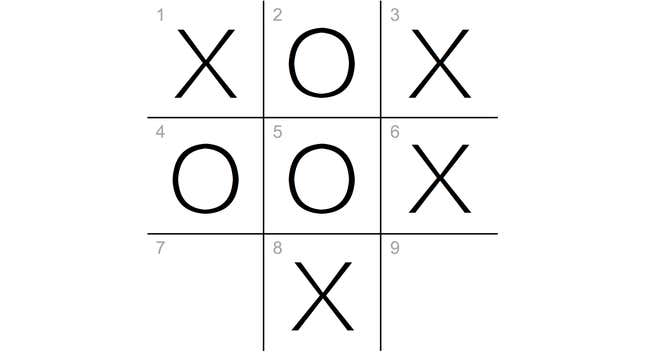
Games are a bottomless reservoir of puzzle inspiration. This is because games and puzzles both tend to be founded on a concise set of logical rules. This week’s puzzle concerns one of the simplest strategy games ever devised: tic-tac-toe. Don’t feel too assured, though. You may be a tic-tac-toe expert, but have you ever tried to play it backwards?
Did you miss last week’s puzzle? Check it out here, and find its solution at the bottom of today’s article. Be careful not to read too far ahead if you’re still working on that puzzle!
Puzzle #2: Reverse Tic-Tac-Toe
Credit to Alain Brobecker for creating this neat puzzle.

The tic-tac-toe position above was reached in a game between two flawless players, meaning neither of them ever made a move that would allow their opponent to win by force and neither of them missed an opportunity to force a win themselves. What were the last four moves played?
You may already know that, with perfect play, tic-tac-toe always ends in a tie where neither player achieves three-in-a-row. So it’s no surprise that a game between two flawless players looks to be headed for stalemate. But how did we get here? To uncover the past, you’ll really need to convince yourself of each move. Producing a plausible-looking sequence of moves will not suffice, because only one such sequence could have occurred under the stipulation of flawless play. Although tic-tac-toe is a small game, the solution requires a sizable dose of deduction. To aid discussion in the comments, let’s number the squares like a telephone.

While playing tic-tac-toe, the past is irrelevant. The move you make in any given position never depends on how you reached that position. So it’s impressive that a static diagram from a game where the past does not matter can have the last four moves uniquely determined. This is the subject of retrograde analysis puzzles (or “retros,” for those in the know), which present a position from some game and require you to deduce something about the history of the game. Chess is the granddaddy of the retro genre. Its rigid rules allow for staggering constructions like the position here, which asks you to determine the last 96 moves! Solvers must dust off trace evidence from long-gone events, like a paleontologist inferring dinosaur diets from scratch marks on fossilized teeth.
While I adore chess puzzles of all types (and have composed a few retros myself), I am unlikely to run them here for the foreseeable future because I wouldn’t want to alienate readers who don’t play. For a delightful introduction to chess retros, check out Raymond Smullyan’s book, The Chess Mysteries of Sherlock Holmes.
We will post the solution to the tic-tac-toe teaser next Monday along with a new puzzle. Do you know a great puzzle that you think we should cover here? Send it to us: [email protected]
Solution to Puzzle #1: 10 Bags of Coins
Last week’s puzzle asked you to discover counterfeit coins with a one-time use scale. The key idea in the solution is to include a different number of coins from each bag in the weighing. Let’s start by labeling the bags 1 through 10 arbitrarily. We’ll place one coin from bag 1 on the scale, two coins from bag 2, three coins from bag 3, and so on, ending with all 10 coins from bag 10. If you didn’t solve the puzzle, pause for a moment and ask yourself how you would deduce which bag holds the counterfeits from the result of this particular weighing.
We can reason through it this way: what would the scale display if every coin weighed 1 gram and there were no fakes? Adding the one coin from the first bag, two coins from the second bag, etc., yields 55 grams (skeptics can check my sum). So if we expect 55 grams with no counterfeits, what would the scale say if the heavier coins happened to live in bag 1? We only included one coin from bag 1 in our weighing, so swapping a single 1-gram coin for a 1.1-gram coin would increase the 55 grams to 55.1 grams. What if bag 2 happened to hold the heavier coins? Then our 55 grams would grow to 55.2 grams because the two coins from bag 2 would now each contribute 0.1 extra grams to the total weight. This continues so that, no matter which bag contains the fakes, the scale shows a predictably different weight. In fact, the digit after the decimal point tells you exactly which bag is the culprit! (Technically, if it’s bag 10, then the weight would be 56 grams.)
There is a whole, rich world of coin-weighing puzzles. They all challenge solvers to find counterfeit coins with a limited number of weighings, but they typically involve a balance scale that only tells you whether the coins in one dish are heavier or lighter than those in the other (or equal). This puzzle is special in that you get a proper numeric scale but the minimum possible number of weighings. I also find the solution particularly elegant.
Did you solve the first Gizmodo Monday Puzzle? Was it too hard? Too easy? Just right? We would love to hear your feedback as we continue to shape the future of this series!

